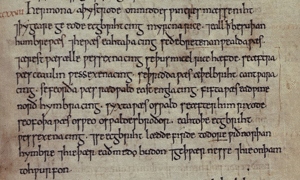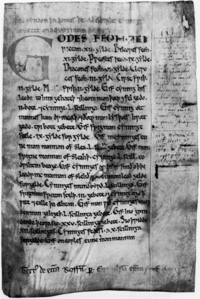Æthelberht of Kent facts for kids
Quick facts for kids Saint Æthelberht |
|
|---|---|
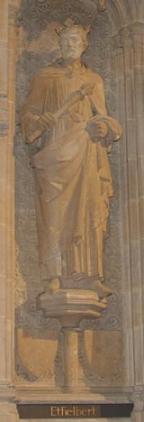
Statue of Æthelberht
Interior of Rochester Cathedral |
|
| King of Kent | |
| Reign | c. 589 – 616 AD |
| Predecessor | Eormenric |
| Successor | Eadbald |
| Born | c. 550 |
| Died | 24 February 616 AD |
| Burial | St Augustine's Abbey |
| Consort | Bertha of Kent |
| Issue | Eadbald Æthelburg Æðelwald |
| House | Kent |
| Father | Eormenric |
| Religion | Christianity prev. Anglo-Saxon paganism |
Æthelberht (also spelled Æthelbert or Ethelbert) was the King of Kent from about 589 until he died in 616 AD. He is famous for being the first English king to become a Christian.
An old monk named Bede wrote in his book, Ecclesiastical History of the English People, that Æthelberht was a very powerful king. He was seen as a "Britain-ruler" or bretwalda, meaning he had power over other Anglo-Saxon kingdoms.
Æthelberht was the son of Eormenric, who was also a king. Æthelberht married Bertha, a Christian princess from the Franks, a powerful kingdom in Europe. This marriage helped Kent become friends with a strong ally. Bertha's faith might have encouraged Pope Gregory I to send Augustine as a missionary (someone who spreads a religion) from Rome. Augustine arrived in Kent in 597.
Soon after, Æthelberht became a Christian. Churches were built, and many people in Kent started to become Christians too. He gave land in Canterbury for a new church, which became very important for Christianity in England.
Æthelberht also created the first written laws in any Germanic language. These laws were for Kent and set up a system of fines for different actions. Kent was a wealthy kingdom with strong trade links to Europe. During his rule, coins were probably used in Kent for the first time since the Anglo-Saxon settlement. Later, Æthelberht was recognized as a saint because of his important role in bringing Christianity to the Anglo-Saxons.
Contents
Early Kent and Its Kings
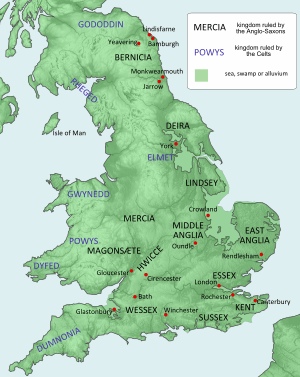
In the 400s, groups like the Angles, Saxons, and Jutes came to Britain from Europe. They settled in the east and south of England. Kent was likely settled by the Jutes.
Legend says that two brothers, Hengist and Horsa, came to Kent in 449. They were hired as soldiers by a British king. After a fight, Hengist supposedly started the Kingdom of Kent. Many historians believe Kent was founded around the mid-400s. This early start suggests that more of the old Roman way of life might have continued in Kent than in other parts of England.
Kings in Anglo-Saxon England often had "overlordship" over other smaller kingdoms. This meant they had authority and could demand tribute or military help. This system was common even before Æthelberht's time.
Sources of Information
Most of what we know about this time comes from a few old writings:
- The Ecclesiastical History of the English People, written by Bede in 731. Bede focused on how England became Christian. Since Æthelberht was the first Christian king, Bede wrote a lot about him.
- The Anglo-Saxon Chronicle, a collection of historical records put together around 890. It mentions several events during Æthelberht's reign.
- Letters from Pope Gregory the Great about St. Augustine's mission to Kent in 597.
- Old lists of kings and land grants (charters), though the original documents from Æthelberht's time don't exist anymore, only later copies.
- Æthelberht's own law code, which has survived.
Family and When He Became King
According to Bede, Æthelberht was a direct descendant of Hengist, the legendary founder of Kent. His father was Eormenric. Æthelberht also had a sister named Ricole, who was the mother of Sæberht, the king of the East Saxons.
Historians debate the exact dates of Æthelberht's birth and when he became king. Bede said he ruled for 56 years and died in 616, which would mean he became king in 560. However, Bede also said Æthelberht died 21 years after his baptism, and Augustine's mission (which converted him) arrived in 597. This means the dates don't quite match up.
Most historians now think Æthelberht was born around 560 and became king around 589 or 590. His marriage to Bertha probably happened around 580.
Kent as a Kingdom
Kent was sometimes divided into two parts: East Kent and West Kent. There was usually one main king who ruled over both. It's possible that Æthelberht ruled East Kent, and his son, Eadbald, ruled West Kent, with Æthelberht being the main ruler.
The main towns of these two parts were Rochester for West Kent and Canterbury for East Kent. Canterbury was clearly Æthelberht's main city.
Connections with the Franks

Kent had very close ties with the Franks, a powerful kingdom in what is now France. Æthelberht's marriage to Bertha, a Frankish princess, was a key connection. Even though the Franks saw Æthelberht as a lesser king, there is no clear record that he accepted them as his overlords.
Pope Gregory the Great wrote a letter in 601 that suggested the Frankish kings had some authority over Kent. However, this might have just been a polite way for the Pope to encourage the Franks to help spread Christianity. Bertha also brought a Frankish bishop, Liudhard, with her to Kent, which shows the strong religious connection.
There was a lot of trade between Kent and the Franks. Expensive goods like fancy clothing, drinks, and weapons found in Kentish burial sites show a strong Frankish influence. Kent had more imported goods than other Anglo-Saxon areas because it was easier to trade across the English Channel. This trade made Kent very wealthy.
Becoming a Powerful Ruler
The Bretwalda
Bede listed seven kings who held imperium, or "overlordship," over other kingdoms south of the Humber River. Æthelberht was the third on this list. The Anglo-Saxon Chronicle later called these kings bretwaldas, meaning "Britain-rulers." This title likely meant they were strong military leaders.
Before Æthelberht, Ceawlin of Wessex was the bretwalda. The Anglo-Saxon Chronicle says Ceawlin fought Æthelberht in 568 and pushed him back to Kent. However, the dates in the Chronicle for this period are not always reliable.
By 601, Æthelberht was clearly a dominant ruler. Pope Gregory wrote to him, asking him to help spread Christianity among the kings and people under his rule. This shows Æthelberht had significant influence over other kingdoms.
Influence Over Other Kingdoms
Æthelberht had power in several southern kingdoms.
- In Essex, he helped his nephew, King Sæberht of Essex, become a Christian around 604. Æthelberht, not Sæberht, built and supported St. Paul's in London. Bede clearly states that Æthelberht was Sæberht's overlord.
- With Rædwald, king of East Anglia, Æthelberht's power was less strong. Rædwald became Christian while in Kent but kept his old pagan beliefs too. He also kept control of his own army. This suggests Æthelberht's influence over East Anglia was not as complete as it was over Essex.
Æthelberht's influence was widespread enough that he could arrange a meeting in 602 near the River Severn, on the western edge of Wessex. This shows how far his power reached.
Augustine's Mission and Christianity
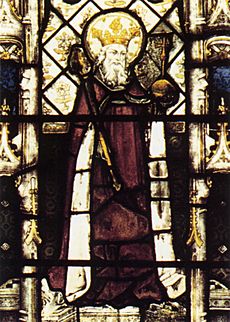
The native Britons in England had become Christian under Roman rule. But after the Anglo-Saxon invasions, the British church was cut off from the rest of Europe. Æthelberht, however, knew about the Roman church because of his wife, Bertha. She had a bishop, Liudhard, with her, and Æthelberht even built a chapel for them, St Martin's.
In 596, Pope Gregory the Great sent Augustine and about 40 monks to England. They landed on the Isle of Thanet in Kent in 597. Bede says Æthelberht was careful at first, insisting on meeting them outdoors to prevent any magic. But the monks impressed him, and he allowed them to settle in Canterbury and preach.
It's not known exactly when Æthelberht became Christian. He might have known about Christianity before Augustine arrived, perhaps from Bertha. Some historians think he might have delayed his conversion to show independence from Frankish influence. By 601, he was definitely a Christian king, as Pope Gregory wrote to him as such.
Through Æthelberht's influence, his nephew Sæberht of Essex also converted. However, not everyone in Kent became Christian right away. Æthelberht's son, Eadbald, was still a pagan when he became king. Rædwald of East Anglia only partly converted. Augustine also struggled to get the British clergy to join his mission.
Æthelberht's Law Code
Some time after Augustine's arrival, perhaps around 602 or 603, Æthelberht issued a set of laws. These laws are the oldest surviving written laws in any Germanic country. They were likely among the first documents written down in Old English, as writing came to England with Augustine's mission. The only surviving copy is from the 1100s and is called the Textus Roffensis.
The laws begin by mentioning the church, listing the compensation needed if someone harms church property or people like a bishop or priest. However, the laws themselves don't seem very influenced by Christian ideas. They focus on setting fines for different wrongdoings, with the fine depending on the social rank of the victim. The king benefited financially from these fines, but he was also responsible for keeping law and order and preventing blood feuds (long-running disputes between families).
One of Æthelberht's laws shows an old custom: "If the king is drinking at a man's home, and anyone commits any evil deed there, he is to pay twofold compensation." This refers to the ancient practice of the king traveling and being hosted by his subjects.
Some parts of the law code might describe a woman's financial rights after a divorce or separation. However, it has also been suggested that these parts refer to women who become widows.
Trade and Coinage
Kent was a wealthy kingdom, and it's believed that Æthelberht took control of trade, making it a royal business. This gave him an advantage in trading with other Anglo-Saxon kingdoms and brought in a lot of money.
Kentish craftspeople were skilled, making glass cups and jewelry. They started using gold before the end of the 500s. Goods from Kent have been found in burial sites across the English Channel. It's not clear what Kent traded for all its wealth, but it's possible they traded slaves. This wealth likely made Æthelberht very powerful.
It's thought that the first coins in England since the Romans left were made during Æthelberht's reign. None of these coins have his name on them, but they likely date from before the end of the 500s. These early gold coins were probably the "shillings" mentioned in Æthelberht's laws.
Death and Succession
Æthelberht died on February 24, 616. His son, Eadbald, became the next king. Eadbald was not a Christian at first. Bede says he went back to his pagan faith, though he eventually became Christian. Eadbald also upset the church by marrying his stepmother, which was against church rules.
Around the same time, Sæberht of the East Saxons also died, and his three sons, who were not Christian, took over. A rebellion against Christianity and the missionaries happened in Kent after Æthelberht's death. This might have been a reaction to Kent's power over other kingdoms, as well as opposition to Christianity.
Some historians think Æthelberht might have had another son named Æthelwald, but this is not certain.
Saint Æthelberht
Æthelberht is considered a saint because of his important role in bringing Christianity to the Anglo-Saxons. His special day was originally February 24, but it was later changed to February 25. The Roman Catholic Archdiocese of Southwark, which includes Kent, celebrates him on February 25.
He is also honored in the Eastern Orthodox Church as Saint Ethelbert, King of Kent, with his day celebrated on February 25.
See Also
 In Spanish: Ethelberto de Kent para niños
In Spanish: Ethelberto de Kent para niños
- Kentish Royal Legend


